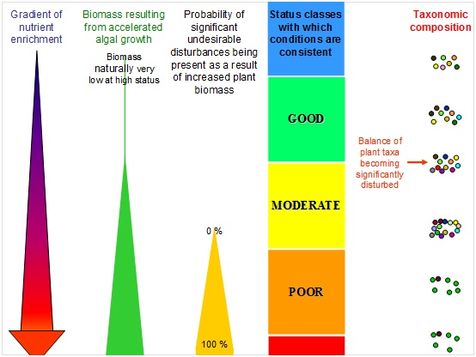Waterframework Directive and Eutrophication

|
The Water Framework Directive (WFD) requires Member States to classify their surface water bodies according to their ecological status. The ecological quality status of a water body can be classified as: high, good, moderate, poor or bad. The WFD further states that Member States should aim to restore the ecological quality status of all surface waters to good unless doing so would be unfeasible or disproportionately expensive.
One of the many different anthropogenic pressures that can effect the ecological status of water bodies is nutrient enrichment which causes electrification. Therefore, although the WFD does not use the term eutrophication, it does implicitly require Member States to remove anthropocentric eutrofic conditions from all inland and coastal surface waters.
Ecological Quality Status in the Waterframework directive
The ecological quality status of a water body measures how much the aquatic ecosystem has been altered by anthropogenic influence. To judge this, one must compare the current condition with reference conditions which haven't been altered anthropologically. The difference in ecosystem conditions compared to these reference conditions is expressed by the 5 ecological status classes.
The WFD requires the individual assessment of different ecosystem components which will each be classified according to their ecological quality status.
- High ecological quality status refers to water bodies with no, or only very minor, anthropogenic alterations, neither in the physico-chemical nor in the biological quality elements.
- Good ecological quality status refers to water bodies in which the biological quality elements for the surface water body type show low levels of distortion resulting from human activity.
- Moderate ecological quality status refers to water bodies in which the the values of the biological quality elements deviate moderately from undisturbed conditions.
- Water bodies in which the ecological quality status is worse than moderate will be classified as poor or bad.
Relevant ecosystem components - which need to be classified by the WFD - with regard to eutrophication are physico-chemical elements, which include nutrients and biological quality elements, which include phytoplankton, macroalgae and benthic invertebrate fauna.
For phytoplankton, phytobenthos, and macroalgae to be in a good status, there must be a negligible risk that increased algal growth would cause significant undesirable disturbances to the coastal ecosystem. Additionally, increased nutrient input can sometimes cause changes in the taxonomic composition of algae. If these changes adversely effect (or are likely to do so) the functioning of the ecosystem, the system would not have a good quality status.

These normative values are the basis for identifying a suitable boundary for each individual components of this particular ecosystem. Once the boundaries has been set up, the monitoring results can be used to classify the component.
